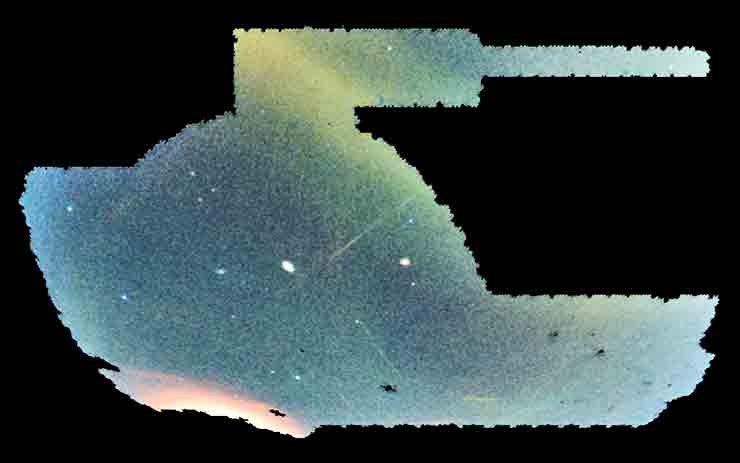Astronomers have discovered 11 new stellar streams—remnants of smaller galaxies torn apart and devoured by our Milky Way.
The finding is among the highlights of the first three years of survey data from the Dark Energy Survey—research on about 400 million astronomical objects, including distant galaxies as well as stars in our own galaxy.

The Dark Energy Survey, a collaboration that aims to reveal the nature of the mysterious force of dark energy, announced the results.
The Dark Energy Survey
The data cover about 5,000 square degrees, or one-eighth of the entire sky, and include roughly 40,000 exposures taken with the Dark Energy Camera. The images correspond to hundreds of terabytes of data and are being released along with catalogs of hundreds of millions of galaxies and stars.
“We can use these streams to measure the amount, distribution, and ‘clumpiness’ of dark matter in the Milky Way.”
“There are all kinds of discoveries waiting to be found in the data,” says Brian Yanny of Fermi National Accelerator Laboratory, and Dark Energy Survey data management project scientist.
“While DES scientists are focused on using it to learn about dark energy, we wanted to enable astronomers to explore these images in new ways, to improve our understanding of the universe,” Yanny says.
The Dark Energy Camera, the primary observation tool of the Dark Energy Survey, is one of the most powerful digital imaging devices in existence. It was built and tested at Fermilab, the lead laboratory on the Dark Energy Survey, and is mounted on the National Science Foundation’s 4-meter Blanco telescope in Chile. A team at the National Center for Supercomputing Applications at the University of Illinois at Urbana-Champaign then processes the DES images.
A growing galaxy
One new discovery enabled by the data set is the detection of 11 new streams of stars around our Milky Way.
Our home galaxy is surrounded by a massive halo of dark matter, which exerts a powerful gravitational pull on smaller, nearby galaxies. The Milky Way grows by pulling in, ripping apart, and absorbing these smaller systems. As stars are torn away, they form streams across the sky that the Dark Energy Camera can detect.
Is the Milky Way actually kind of weird?
Even so, stellar streams are extremely difficult to find since they are composed of relatively few stars spread out over a large area of sky.
“It’s exciting that we found so many stellar streams,” says astrophysicist Alex Drlica-Wagner of Fermilab and the Kavli Institute for Cosmological Physics at University of Chicago. “We can use these streams to measure the amount, distribution, and ‘clumpiness’ of dark matter in the Milky Way. Studies of stellar streams will help constrain the fundamental properties of dark matter.”
Prior to the new discoveries, only about two dozen stellar streams had been discovered. Many of them were found by the Sloan Digital Sky Survey, a precursor to the Dark Energy Survey. The effort to detect new stellar streams in the Dark Energy Survey was led by Nora Shipp, a graduate student at the University of Chicago.
“We’re interested in these streams because they teach us about the formation and structure of the Milky Way and its dark matter halo. Stellar streams give us a snapshot of a larger galaxy being built out of smaller ones,” says Shipp. “These discoveries are possible because DES is the widest, deepest, and best-calibrated survey out there.”
Since there is no universally accepted naming convention for stellar streams, the Dark Energy Survey has reached out to schools in Chile and Australia, asking young students to select names. Students and their teachers have worked together to name the streams after aquatic words in native languages from northern Chile and aboriginal Australia.
Vast halo of hydrogen surrounds Milky Way
The researchers presented the initial findings of the Dark Energy Survey during the American Astronomical Society meeting in Washington, DC on January 10.
Funding came from the US Department of Energy Office of Science and the National Science Foundation.
Source: University of Chicago



